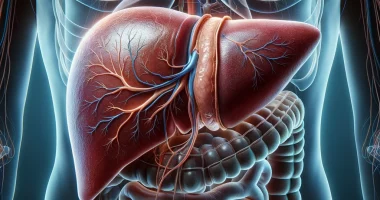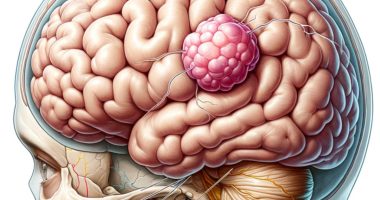Cluster headache
Definition
Cluster headache is a primary unilateral cephalgia accompanied by periodic recurrent attacks in the periorbital region and combined with ipsilateral disorders of the autonomic nervous system. Diagnosis is based on clinical symptoms, anamnesis data, and differentiation with other hemicrania. Treatment is represented by drugs from the groups of triptans, anticonvulsants, calcium channel blockers, corticosteroids, topical anesthetics, and oxygen inhalation. Suboccipital blockade and percutaneous stimulation of the occipital nerve, radiofrequency rhizotomy, and other techniques are used.
General information
Cluster headache is a rare form of cephalgia diagnosed in 0.1-0.4% of the population. The prevalence of pathology ranges from 55 to 200 cases per 100 thousand population. Hereditary character is traced only in 2.5-4% of patients. Cluster headache is much more often detected in men – among patients, there is a 3-4-fold predominance of males. Women are characterized by two peaks of morbidity at the age of 15 to 20 years and 45 to 50 years; in men, this variant of pathology usually debuts at the age of 20-29 years.
Causes of cluster headaches
The exact etiology of the disease has yet to be established. It is believed that one of the leading roles in the development of the disease is played by the pathological activity of the hypothalamus, which is indirectly confirmed by the rhythmicity of headache episodes. Trigger factors that can cause new attacks are individualized for each patient. According to statistics, more often than others, pain provocation is caused by:
- Alcohol intake. Even small doses of alcoholic beverages can potentiate an exacerbation. Alcohol-induced attacks are not usually prevented by medications that are usually effective for cluster headaches. The pain syndrome occurs only during the cluster period – during remission; alcohol is rarely the cause of relapse.
- Medications. Sometimes, medications such as histamine (given intravenously or subcutaneously) and nitroglycerin (sublingual form) cause an episode.
- Emotional and physical stress. In some patients, aggravation of pain is noted when watching TV or prolonged work with a personal computer. Deterioration of the condition can be observed with any tension and efforts imitating the Valsalva test (holding the breath after deep inhalation).
Classification
Depending on the peculiarities of the course, several forms of bundle hemicrania are distinguished. The systematization is based on the frequency of attacks; the clinical symptoms of the disease are almost identical. Thanks to the use of this classification and patient management tactics, the choice of therapeutic agents is simplified. There are two variants of cluster headache, which, over time, can be transformed from one to the other:
- Episodic. It was diagnosed in 80-90% of patients. There are more than 2 cluster periods with a total duration from 7 days to 1 year (usually from 14 to 90 days), between which there are clinical remissions lasting at least 30 days.
- Chronic. It occurs in at most 20% of patients and is characterized by the development of episodes of cephalgia lasting one year or longer without clinical remission or with remissions not exceeding one month. It is often resistant to treatment.
Symptoms
The headache is acute in exacerbations and peaks in 1 to 3 minutes. The average duration of an episode is less than 1 hour and can range from 15 to 180 minutes. The attack stops as quickly as it started. Series “clusters” are often observed) ranging from one attack in 2 days to eight (average of two to four) in 24 hours. The attacks usually occur at the same time, predominantly at night. In a typical disease course, the exacerbation period lasts from 14 days to 2 months.
Clinically, each attack is characterized by unilateral, more often left-sided, unbearable pain of a burning or stabbing nature with an epicenter in the eyeball area. Irradiation to the affected side’s cheek, ear, and teeth is observed. Trigger zones are identified; when pressure is applied to them, the pain syndrome increases the belt muscles of the neck, the same-named muscles of the head, and the trapezius muscle. Rarely does the pain spread to the neck, shoulder, and scapula ipsilaterally. One-third of patients experience nausea followed by vomiting and photophobia.
Cluster headache is characterized by a specific behavior of the patient during the attack – the inability to maintain a motionless horizontal position. It is explained by partial relief of the pain syndrome with moderate physical activity. During an exacerbation, the patient can throw himself from side to side, clap his hands, or beat the wall with his fist. An obligatory sign of a cluster pain attack is autonomic disorders of increased parasympathetic tone and hypoactivation of the sympathetic nervous system. Clinically, this is manifested by nasal congestion and mucous discharge, hypersalivation, conjunctival hyperemia, hyperhidrosis in the orbital region, and Horner syndrome (ptosis, miosis, and enophthalmos) ipsilaterally.
Diagnosis
The diagnosis of cluster cephalgia is based on the analysis of clinical symptoms and differentiation from other forms of paroxysmal hemicrania. When interviewing the patient, the neurologist carefully details the complaints and clarifies the presence of trigger factors and episodes of similar pathologies among blood relatives. With atypical clinical manifestations, suspicion of traumatic injury, tumors, or other morphological changes in the CNS can be used hardware imaging methods – CT and MRI of the brain. After ruling out organic pathology, the doctor compares the interview data with the diagnostic criteria for cluster headache according to the International Classification of Headaches (ICHD-II), which includes:
- A. Presence of at least five seizures falling under criteria B-D.
- B. Extremely severe unilateral pain of periorbital or temporal localization that persists for 15-180 minutes without treatment.
- C. In addition to headache, one or more of the following signs are identified:
- conjunctival injection and/or excessive tear production;
- marked edema of the nasal mucosa and/or rhinorrhea;
- swollen eyelids;
- hyperhidrosis of the forehead and face;
- pupil dilation or eyelid drooping;
- inability to maintain a calm lying position or agitation.
- D. The frequency of attacks ranges from once every two days to 8 times daily.
- E. Lack of reliable association with other probable disorders.
Differential diagnosis of cluster headache is performed with migraine, trigeminal neuralgia, and paroxysmal hemicrania. Distinctive features of migraine are the patient’s tendency to rest during cephalgia, the presence of aura, and an aggravated family history. Trigeminal neuropathy is characterized by short-term pain lasting a few seconds, which patients describe as “electric shock,” exacerbation of pain with the tension of the masticatory muscles. Unlike cluster cephalgia in trigeminal neuralgia, patients are afraid to touch their faces, as this causes new attacks of pain. Paroxysmal hemicrania is more characteristic of women; the attack lasts no more than 30 minutes, and the frequency can reach 40 attacks per day.
Treatment
There is no etiotropic treatment for cluster headaches at the moment. The pharmacotherapeutic agents used are aimed at combating the already developed pain syndrome, reducing the frequency of attacks in the structure of the “cluster,” and preventing new attacks during the exacerbation period. Thus, the following basic approaches are distinguished in the therapy of cluster headache:
- Management of cephalgia attacks. Effective drugs in the fight against cluster pain are triptans. In case of intolerance to this group, inhalation of 100% oxygen is used, local anesthetics to the nasal mucosa are applied, and ergot preparations are used less frequently.
- Prevention of new attacks. The basis of preventive treatment is calcium channel blockers (verapamil). In case of resistance, corticosteroids and antiepileptic drugs are recommended.
Surgical treatment of cluster headaches is resorted to when various combinations of drug therapy are ineffective. Invasive techniques include blockade and percutaneous neurostimulation of the greater occipital nerve, hypothalamic stimulation, radiofrequency thermocoagulation of the trigeminal ganglion, and radiofrequency trigeminal rhizotomy.
All these treatment options are available in more than 90 hospitals worldwide (https://doctor.global/results/diseases/chronic-daily-headache-cdh). For example, Occipital nerve stimulation can be done in 4 clinics across India for an approximate price of $7,4K (https://doctor.global/results/asia/india/all-cities/all-specializations/procedures/occipital-nerve-stimulation).
Prognosis and prevention
The probability of recovery depends directly on the characteristics of the pathology and the patient’s response to therapy. In medical practice, cases of complete clinical remission of the disease have been described. Cluster headache is characterized by a decrease in the frequency of attacks and their severity with age. Specific prevention of cluster cephalgia has not been developed. There is no evidence base for the prevention of new exacerbations with prolonged use of medications. Nonspecific preventive measures include eliminating or minimizing the impact of triggering factors that can cause new attacks of headache.


